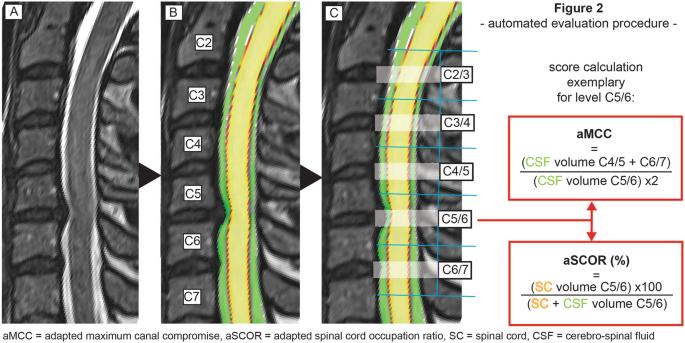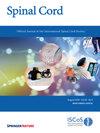Quantification of cervical spinal stenosis by automated 3D MRI segmentation of spinal cord and cerebrospinal fluid space
IF 2.1
4区 医学
Q3 CLINICAL NEUROLOGY
引用次数: 0
Abstract
Prospective diagnostic study. Anatomical evaluation and graduation of the severity of spinal stenosis is essential in degenerative cervical spine disease. In clinical practice, this is subjectively categorized on cervical MRI lacking an objective and reliable classification. We implemented a fully-automated quantification of spinal canal compromise through 3D T2-weighted MRI segmentation. Medical Center - University of Freiburg, Germany. Evaluation of 202 participants receiving 3D T2-weighted MRI of the cervical spine. Segments C2/3 to C6/7 were analyzed for spinal cord and cerebrospinal fluid space volume through a fully-automated segmentation based on a trained deep convolutional neural network. Spinal canal narrowing was characterized by relative values, across sever segments as adapted Maximal Canal Compromise (aMCC), and within the index segment as adapted Spinal Cord Occupation Ratio (aSCOR). Additionally, all segments were subjectively categorized by three observers as “no”, “relative” or “absolute” stenosis. Computed scores were applied on the subjective categorization. 798 (79.0%) segments were subjectively categorized as “no” stenosis, 85 (8.4%) as “relative” stenosis, and 127 (12.6%) as “absolute” stenosis. The calculated scores revealed significant differences between each category (p ≤ 0.001). Youden’s Index analysis of ROC curves revealed optimal cut-offs to distinguish between “no” and “relative” stenosis for aMCC = 1.18 and aSCOR = 36.9%, and between “relative” and “absolute” stenosis for aMCC = 1.54 and aSCOR = 49.3%. The presented fully-automated segmentation algorithm provides high diagnostic accuracy and objective classification of cervical spinal stenosis. The calculated cut-offs can be used for convenient radiological quantification of the severity of spinal canal compromise in clinical routine.


通过自动三维核磁共振成像分割脊髓和脑脊液空间,量化颈椎管狭窄程度
目的对颈椎退行性疾病进行解剖学评估和椎管狭窄严重程度分级至关重要。在临床实践中,这主要是通过颈椎磁共振成像进行主观分类,缺乏客观可靠的分类方法。我们通过三维 T2 加权磁共振成像分段对椎管狭窄进行了全自动量化。通过基于训练有素的深度卷积神经网络的全自动分割,对 C2/3 至 C6/7 截面的脊髓和脑脊液空间体积进行分析。椎管狭窄以相对值为特征,各节段的相对值为适应性最大椎管狭窄(aMCC),指数节段内的相对值为适应性脊髓占位比(aSCOR)。此外,所有节段均由三名观察者主观分为 "无"、"相对 "或 "绝对 "狭窄。结果 798 节段(79.0%)被主观归类为 "无 "狭窄,85 节段(8.4%)为 "相对 "狭窄,127 节段(12.6%)为 "绝对 "狭窄。计算得出的分数显示,每个类别之间存在明显差异(P ≤ 0.001)。ROC 曲线的尤登指数分析显示,在 aMCC = 1.18 和 aSCOR = 36.9% 时,最佳临界值可区分 "无 "和 "相对 "狭窄;在 aMCC = 1.54 和 aSCOR = 49.3% 时,最佳临界值可区分 "相对 "和 "绝对 "狭窄。计算出的临界值可用于在临床常规工作中对椎管狭窄的严重程度进行方便的放射学量化。
本文章由计算机程序翻译,如有差异,请以英文原文为准。
求助全文
约1分钟内获得全文
求助全文
来源期刊

Spinal cord
医学-临床神经学
CiteScore
4.50
自引率
9.10%
发文量
142
审稿时长
2 months
期刊介绍:
Spinal Cord is a specialised, international journal that has been publishing spinal cord related manuscripts since 1963. It appears monthly, online and in print, and accepts contributions on spinal cord anatomy, physiology, management of injury and disease, and the quality of life and life circumstances of people with a spinal cord injury. Spinal Cord is multi-disciplinary and publishes contributions across the entire spectrum of research ranging from basic science to applied clinical research. It focuses on high quality original research, systematic reviews and narrative reviews.
Spinal Cord''s sister journal Spinal Cord Series and Cases: Clinical Management in Spinal Cord Disorders publishes high quality case reports, small case series, pilot and retrospective studies perspectives, Pulse survey articles, Point-couterpoint articles, correspondences and book reviews. It specialises in material that addresses all aspects of life for persons with spinal cord injuries or disorders. For more information, please see the aims and scope of Spinal Cord Series and Cases.
 求助内容:
求助内容: 应助结果提醒方式:
应助结果提醒方式:


